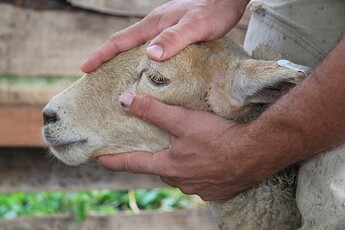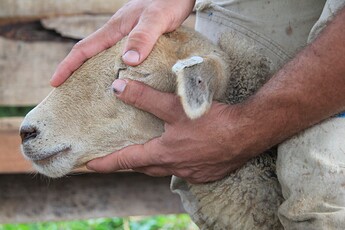Internal parasites are a major limiting factor in raising livestock, especially in small ruminants (sheep and goats). Barber Pole Worms (Haemonchus contortus) are by far the most widespread and damaging internal parasites. These roundworms attach themselves to the inner lining of the abomasum (the fourth stomach in the ruminant digestive system) and feed on the animals’ blood. Essentially all ruminants have at least some worms in the digestive system; however, the populations can eventually become so high that the amount of blood being lost begins to affect the performance of livestock. The more worms there are, the more anemic the animals become.
Parasite prevention is key to livestock health; a well-managed herd or flock will have fewer parasite issues in general. That said, everyone raising livestock will have to deal with parasite issues at some point. There are many ways to treat gastrointestinal parasites. Commercial chemical dewormers and dewormers derived from natural products can both be effective ways to control infestations. There are many different philosophies about how to go about using those products; however, no matter how you choose to treat your animals, the treatment will always be more effective if you catch the parasite infestations early. It is important to monitor the health of your flock or herd on a regular basis, and checking for anemia is an integral part of livestock health observations.
FAMACHA scoring is a method that can be used to visually estimate whether an animal has a high parasite load, and whether or not they need to be treated. FAMACHA uses a card with a 5-part color scale, which is used by visually matching the color of the mucous membrane in the lower eyelid to one of the colors on the card. This system was developed in South Africa, and in the US is regulated by the American Consortium for Small Ruminant Parasite Control. I highly recommend that anyone who raises small ruminants familiarize yourself with the FAMACHA system (https://www.wormx.info/famacha). In order to get a FAMACHA card, you must take a class and become certified.
If you do not have access to a FAMACHA card or certification program, the principles still apply. Here is an outline of the basic steps to determining whether an animal is anemic:
Step 1- Secure the animal. You may use a headgate or milking stand. You need to be able to hold their head, and I find it easiest and simplest to just straddle the animal with my legs. To hold the head, place one hand under the chin and one across the forehead. Both thumbs should be able to touch the eye. Be careful to not place your lower hand across the throat; the animals needs to be able to breathe and swallow.
Step 2- Close the eye with the thumb from your top hand and push down gently. The eye will sink into the socket slightly.
Step 3- Pull down on the lower eyelid with your lower thumb. The eyelid should turn “inside-out” easily.
Now that you have seen the color of the mucous membrane, you can make an educated guess about whether to treat an individual animal. Red is the ideal color (as seen in the picture). Paler red/pink is ok. Very pale or white means the animal is anemic. A FAMACHA score of 4 or 5 means that the animals needs treatment as soon as possible (that means today, not tomorrow).
It is very difficult to give each animal a true “score” without a FAMACHA card. I do recommend taking a course to anyone who had access. But even without the card, using anemia as a guide to treatment is better than nothing, and could have a very positive impact on livestock operations.
Special thanks to Cinnamon the Sheep for her contribution to this post!




